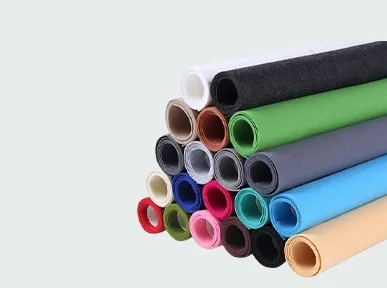Exploring the Versatility and Benefits of Felt Material in Everyday Applications
The Versatile World of Felt Material A Practical Overview
Felt material, a non-woven textile made from natural or synthetic fibers, has been used across various cultures and industries for centuries. Its unique properties make it a popular choice for a wide range of applications, from fashion to home décor, and even in industrial settings. This article delves into the characteristics, uses, and benefits of felt, showcasing its versatility and practicality.
What is Felt?
Felt is created by matting, condensing, and pressing fibers together. This process can involve different types of fibers, including wool, acrylic, and polyester. Wool felt, made primarily from sheep's wool, is renowned for its durability, softness, and insulating properties. Synthetic felt, on the other hand, is often lighter and water-resistant, making it suitable for various applications.
Properties of Felt
One of the most distinctive features of felt is its density. Unlike woven or knitted fabrics, felt does not fray, making it ideal for crafting and other projects where a clean edge is crucial. Felt is also lightweight yet strong, allowing for flexibility in various applications. Additionally, its insulating properties make it a perfect material for soundproofing and temperature regulation, making it popular in construction and home building.
Uses of Felt Material
Felt material is immensely versatile. In the world of fashion, felt is commonly used to create hats, coats, and handbags. Designers appreciate its ability to hold shape while providing a unique texture and aesthetic. In home décor, felt can be found in rugs, wall hangings, and pillows, adding warmth and a touch of elegance to any space.
felt material

Moreover, felt is widely used in educational settings, particularly in early childhood education. Felt boards are a favorite tool for teachers, allowing for interactive storytelling and skill-building exercises. Children can easily manipulate felt shapes, fostering creativity and fine motor skills.
Industrial applications of felt are also notable. It is often used for insulation in buildings and machinery, as well as for gaskets and seals due to its compressibility and resistance to wear. The automotive industry values felt for sound dampening and enhancing interior acoustics.
Benefits of Using Felt
One of the significant benefits of using felt is its eco-friendliness, especially when opting for wool or recycled fibers. These materials are sustainable, biodegradable, and often produced with minimal environmental impact. Furthermore, felt's durability means that products made from it can last a long time, reducing waste and the need for frequent replacements.
Felt is also relatively easy to work with, making it a favorite among crafters and DIY enthusiasts. Available in an array of colors and thicknesses, it offers endless possibilities for creativity.
Conclusion
Felt material stands out as a practical and beloved fabric in various domains. Its unique properties, wide array of applications, and environmental benefits make it a staple for artists, educators, decorators, and industrial professionals alike. Whether crafting a beautiful garment or insulating a room, felt proves to be a versatile and valuable material that continues to inspire innovation and creativity.
-
What Makes Felt a Great Choice?NewsNov.19,2024
-
Total Mixed Ration (TMR) Feed for CattleNewsNov.19,2024
-
The Ultimate Guide for Felt Polishing WheelsNewsNov.19,2024
-
Industrial Felt for Various ApplicationsNewsNov.19,2024
-
Felt Makeup Bags and Inserts BagsNewsNov.19,2024
-
Choosing the Right Hotel TowelsNewsNov.19,2024
-
Your Go-To Guide For Affordable Wholesale Wool FeltsNewsOct.31,2024







